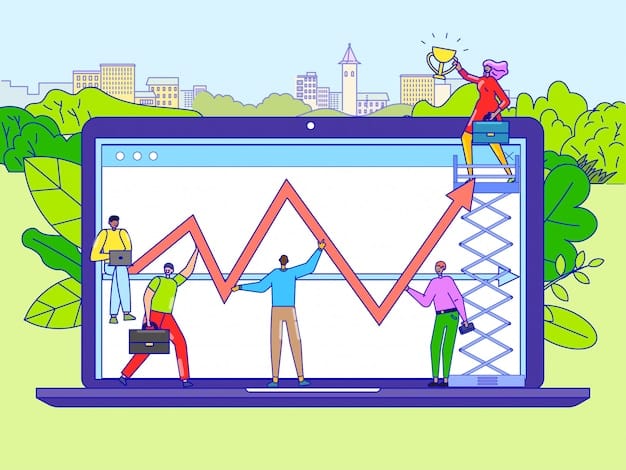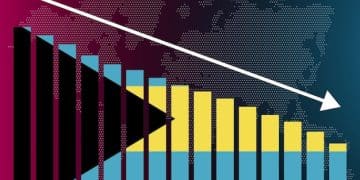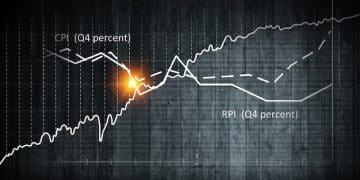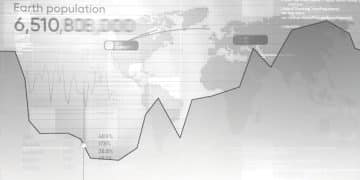Federal Reserve Rate Hike 2025: Expert Analysis & Outlook

The Federal Reserve’s stance on interest rates in early 2025 will hinge on a complex interplay of evolving economic indicators, including inflation trends, labor market strength, and global economic stability, making any definitive prediction speculative and subject to continuous re-evaluation by policymakers.
As 2024 draws to a close, a critical question for investors, businesses, and consumers alike is: Will the Federal Reserve Raise Interest Rates Again in Early 2025? Expert Analysis suggests the answer is far from straightforward. The economic landscape is constantly shifting, and the Fed’s decisions are intricately tied to a myriad of complex indicators. Understanding these underlying factors is crucial for anyone looking to navigate the financial implications of future monetary policy.
The Current Economic Climate: A Precursor to 2025
Before delving into projections for early 2025, it’s essential to understand the current economic backdrop. The Federal Reserve’s monetary policy decisions are not made in a vacuum; they are a direct response to prevailing economic conditions, primarily inflation, employment, and economic growth. Policymakers continuously evaluate these metrics to determine the appropriate course of action.
Inflationary Pressures and Containment Efforts
Inflation has been a central concern for the Federal Reserve over the past few years. After reaching multi-decade highs, the Fed implemented aggressive rate hikes to cool down the economy and bring inflation back towards its 2% target. The effectiveness of these measures is constantly under scrutiny, with policymakers looking for consistent signs of disinflation.
- Core PCE Index: This remains the Fed’s preferred inflation gauge, excluding volatile food and energy prices, offering a clearer picture of underlying price trends. Sustained decreases in core PCE would be a strong signal for the Fed.
- Wage Growth: While beneficial for workers, excessive wage growth can contribute to inflationary pressures by increasing input costs for businesses, potentially leading to a wage-price spiral if not managed correctly.
- Global Commodity Prices: Geopolitical events and global supply chain dynamics continue to influence commodity prices, which can have a significant pass-through effect on domestic inflation.
The path of inflation will be a paramount determinant for the Fed’s actions in 2025. If inflation proves sticky or experiences an unexpected resurgence, the likelihood of further rate hikes increases. Conversely, a clear and sustained trend towards the 2% target would provide the Fed with more flexibility.
Labor Market Dynamics: Strength vs. Cooling
The labor market has shown remarkable resilience, even in the face of tighter monetary policy. Low unemployment rates and solid job creation have been a hallmark of the post-pandemic recovery. However, the Fed seeks a balance: a strong labor market without excessive wage inflation that could reignite price pressures.
- Unemployment Rate: A consistently low unemployment rate provides a strong foundation for consumer spending and economic activity, but the Fed monitors for signs of overheating.
- Job Openings and Quits Rate: These indicators reflect labor demand and worker confidence. A cooling in job openings and quits could signal a rebalancing of the labor market.
- Labor Force Participation: An increase in labor force participation can alleviate wage pressures by expanding the supply of available workers, a positive sign for the Fed.
Any significant weakening in the labor market, such as a sharp rise in unemployment, would likely prompt the Fed to pivot away from a hawkish stance. Conversely, continued tightness could keep the option of further rate hikes on the table, if accompanied by inflationary pressures.
Economists are closely watching for a soft landing scenario, where inflation recedes without a significant economic downturn or mass job losses. The Fed’s policy navigation aims precisely for this delicate balance, relying on a forward-looking assessment of incoming data. The resilience of the U.S. consumer and corporate earnings also play a role, influencing the overall demand side of the economy.
Key Economic Indicators Influencing Fed Decisions in Early 2025
The Federal Reserve employs a data-dependent approach, meaning its decisions are highly responsive to incoming economic information. For early 2025, several key indicators will receive intense scrutiny from policymakers. Understanding these metrics provides insight into the potential trajectory of interest rates.
Inflation Metrics: The Primary Driver
Inflation remains the Fed’s primary concern. While overall inflation has eased, the speed of disinflation and the potential for a rebound are critical. The Fed targets 2% average inflation over time, so sustained progress towards this goal is paramount.
- Personal Consumption Expenditures (PCE) Price Index: This is the Fed’s preferred inflation measure, focusing on consumer spending. Policymakers dissect both headline and core PCE (excluding volatile food and energy components) for underlying trends.
- Consumer Price Index (CPI): While not the Fed’s primary measure, CPI is widely reported and influences public perception of inflation. Divergences between CPI and PCE often complicate the narrative and Fed communication.
- Inflation Expectations: The Fed pays close attention to both consumer and market-based inflation expectations. If these expectations become unanchored, it could lead to self-fulfilling inflationary spirals, necessitating more aggressive action.
Any unexpected uptick in these inflation indicators, especially core measures, could trigger a renewed debate about rate hikes. Conversely, a continuation of the disinflationary trend would likely reinforce a pause or even discussions about rate cuts later in the year.

Labor Market Health: A Balancing Act
The strength of the labor market is a double-edged sword for the Fed. A robust job market supports economic growth and consumer spending but can also contribute to wage-driven inflation. The Fed aims for maximum employment, but within the context of price stability.
- Non-Farm Payrolls: The monthly jobs report provides a snapshot of job creation and the overall health of the labor market. Sustained strong payroll figures could suggest continued economic momentum.
- Average Hourly Earnings: This metric indicates wage growth. If wage growth remains significantly above levels compatible with 2% inflation, it could signal ongoing inflationary pressures.
- Job Openings and Labor Turnover Survey (JOLTS): JOLTS data provides insights into labor demand (job openings) and worker mobility (quits rate), offering clues about the tightness of the labor market.
A significant slowdown in job growth or an unexpected increase in unemployment would be a strong signal for the Fed to ease its stance. However, a persistently tight labor market, particularly if accompanied by rising inflation, creates a complex policy challenge.
Gross Domestic Product (GDP) and Economic Growth
The overall health of the economy, as measured by GDP, influences the Fed’s perception of “neutral” interest rates and the economy’s capacity to absorb higher rates. Stronger-than-expected growth might give the Fed more room to maneuver on rates.
- Real GDP Growth: This measures the total output of goods and services. Sustained robust growth could suggest the economy can handle higher borrowing costs.
- Consumer Spending Data: As a significant component of GDP, consumer spending patterns are vital. Resilient consumer demand, fueled by strong labor markets and savings, can keep the economy humming.
- Business Investment: Trends in corporate investment signal business confidence and future economic capacity. A slowdown here could suggest caution ahead.
Should the economy show signs of sputtering or recessionary pressures emerge, the Fed would likely prioritize supporting growth over further tightening. Conversely, surprisingly strong growth could embolden the Fed to focus more intently on inflation containment.
Global economic conditions also play a role, influencing trade, supply chains, and investor sentiment. The Fed monitors international developments, though its primary mandate remains domestic. The interplay of these diverse data points will dictate the nuanced policy path the Federal Open Market Committee (FOMC) chooses in early 2025.
Expert Forecasts and Disparate Views for 2025
Predicting the Federal Reserve’s actions is rarely a unanimous affair among economists and financial analysts. While some consensus might emerge on broad trends, the exact timing and magnitude of rate changes, especially for early 2025, are subject to diverse interpretations based on differing economic models and assumptions. The range of opinions underscores the inherent uncertainty in economic forecasting.
The “Higher for Longer” Camp
A significant portion of analysts subscribes to the “higher for longer” narrative. This view posits that inflation, particularly core services inflation, will prove stickier than anticipated, requiring interest rates to remain elevated for an extended period, possibly leading to another hike if conditions warrant. This perspective often highlights:
- Persistent Wage Pressures: Strong labor market dynamics continuing to fuel wage growth, which translates into higher business costs and consumer spending.
- Fiscal Spending Influence: Ongoing government deficits and spending potentially adding to aggregate demand and inflationary pressures.
- Decoupling from Goods Disinflation: A recognition that while goods prices have seen significant disinflation, services inflation remains elevated and is harder to bring down.
Proponents of this view suggest that the Fed, having learned lessons from past premature easing, will err on the side of caution, prioritizing a clear return to the 2% inflation target, even if it means a period of slower economic growth or a marginally higher terminal rate. They might argue that the ‘neutral’ rate of interest has increased, meaning policy needs to be more restrictive than previously thought to achieve the Fed’s goals.
The “Softer Landing / Rate Cuts Ahead” Camp
On the other end of the spectrum are those who foresee a softening economy and anticipate rate cuts, possibly beginning in late 2024 or early 2025, rather than further hikes. This perspective is often rooted in:
- Lagged Effects of Rate Hikes: The belief that the full impact of past aggressive rate hikes has yet to be felt across the economy, predicting a more significant economic slowdown in the coming quarters.
- Rapid Disinflation: Projections that inflation will continue its downward trajectory more quickly than the Fed anticipates, allowing for a pivot to accommodative policy. This might be driven by easing supply chains, declining commodity prices, and fading pent-up demand.
- Risk of Recession: Concerns that maintaining high rates for too long increases the risk of a recession, compelling the Fed to cut rates to support economic activity and employment.
These analysts might point to slowing consumer spending, tightening credit conditions, and a cooling housing market as early signs of a broader economic slowdown. They often argue that the Fed’s dual mandate (price stability and maximum employment) will shift emphasis towards employment if inflation continues to recede, prompting rate reductions.
The “Wait-and-See” or “Data-Dependent” Consensus
Despite the differing outlooks, a broad consensus among experts is that the Fed will remain highly data-dependent. This means any firm predictions are subject to immediate revision based on incoming economic data. Policymakers have repeatedly emphasized their commitment to flexibility and their willingness to adjust policy as economic conditions evolve.
- Focus on Forward Guidance: Analysts meticulously dissect every word from Fed officials for clues on their future intentions, recognizing that guidance can shift rapidly.
- Impact of Global Events: Unforeseen global events (e.g., geopolitical conflicts, new economic crises) could dramatically alter the economic outlook and the Fed’s policy response.
- Evolving Economic Models: Economists are constantly refining their models to better understand the nuances of the current economic cycle, which can lead to shifts in forecasts.
The absence of a clear consensus highlights the complexity of the current economic environment. Early 2025 will be a pivotal period, as the Fed balances its mandate between achieving price stability and maintaining a healthy labor market, all while navigating a dynamic global landscape. The ultimate path will likely be a nuanced one, reflecting the Fed’s cautious but adaptable approach.
The Federal Reserve’s Dual Mandate and Its Application in 2025
The Federal Reserve operates under a dual mandate from Congress: to achieve maximum employment and maintain price stability. These two objectives are often intertwined, but at times, achieving one may seem to come at the expense of the other. The challenge for the Fed in early 2025 will be to balance these mandates effectively, especially as the economy potentially transitions from a period of high inflation to one of slower growth.
Maximum Employment: Beyond the Headlines
Maximum employment doesn’t simply mean the lowest possible unemployment rate. It’s a broad concept encompassing a healthy, dynamic labor market where individuals who want to work can find jobs, reflecting a sustainable level of labor force participation and wage growth that aligns with productivity gains. In early 2025, the Fed will assess:
- Unemployment Rate Trends: Is the unemployment rate stable, rising, or falling? A significant uptick could signal a weakening economy and prompt a less restrictive policy stance.
- Labor Force Participation: An increase here would indicate more people rejoining the workforce, which can alleviate wage pressures without undermining employment.
- Underemployment and Job Quality: Beyond headline numbers, the Fed considers how many people are working part-time who want full-time work, and the quality of new jobs being created.
If the labor market shows signs of significant stress, the Fed might lean towards avoiding further rate hikes, or even consider cuts, to prevent a more severe downturn. The goal is to avoid overshooting on tightening and causing avoidable job losses.
Price Stability: The Elusive 2% Target
Price stability is generally defined as an inflation rate of 2% over the long run, as measured by the PCE price index. This target is not a ceiling but a symmetrical average, meaning the Fed is comfortable with inflation temporarily exceeding or falling short of 2% as long as it averages out over time. For early 2025, the Fed’s focus will be on:
- Sustained Disinflationary Trends: Are core inflation measures consistently moving towards 2%? The pace and breadth of disinflation will be key.
- Inflation Expectations: Are long-term inflation expectations remaining anchored at 2%? If consumers and businesses expect higher inflation, it can become a self-fulfilling prophecy.
- Services vs. Goods Inflation: After goods inflation receded, services inflation proved stickier. The Fed will be watching for signs of significant cooling in this component.
If inflation proves persistent or begins to re-accelerate, the Fed would likely prioritize price stability, potentially necessitating further rate hikes, even if it means some short-term pain for the labor market. The historical lesson for the Fed is the cost of allowing inflation to become entrenched.
The interplay between these two mandates will define the Fed’s policy in early 2025. A “soft landing” scenario, where inflation returns to target without a significant rise in unemployment, is the ideal outcome. However, if trade-offs become unavoidable, the Fed’s perceived commitment to either price stability or maximum employment will shift based on the prevailing economic data. This constant recalibration makes forecasting their actions particularly challenging, as policymakers themselves will be continuously weighing the relative dangers of inflation versus recession.
Potential Risks and Black Swan Events for Monetary Policy
While economic models and expert analyses provide a structured framework for understanding potential Federal Reserve actions in early 2025, the real world is subject to unforeseen developments often referred to as “black swan” events. These low-probability, high-impact occurrences can dramatically alter the economic landscape and force abrupt shifts in monetary policy. Beyond these, several significant risks could derail current projections.
Geopolitical Instability: Shocks to Global Supply and Demand
Ongoing geopolitical tensions, new conflicts, or significant shifts in international relations can have profound economic consequences. These might include:
- Energy Price Spikes: Disruptions to global oil and gas supplies due to conflict or sanctions can send energy prices soaring, directly impacting inflation and consumer purchasing power.
- Trade Disruptions: Escalated trade disputes or new protectionist policies can lead to supply chain bottlenecks, increased business costs, and reduced global trade volumes.
- Financial Market Turmoil: Geopolitical risks can trigger episodes of heightened volatility in global financial markets, leading to capital flight, currency fluctuations, and tighter credit conditions.
Any of these scenarios could either reignite inflationary pressures, forcing the Fed to consider further hikes, or trigger a global economic slowdown necessitating a more cautious approach to rates.
Recessionary Pressures: Domestic or Global Contagion
Despite hopes for a soft landing, the risk of a recession remains. This could stem from:
- Over-tightening by the Fed: The cumulative effect of past rate hikes could eventually tip the economy into a recession, prompting a rapid pivot to rate cuts.
- Banking Sector Stress: While the sector has stabilized, unforeseen vulnerabilities or a crisis of confidence could emerge, leading to a credit crunch that stifles economic activity.
- Weakness in Key Sectors: A prolonged slowdown in major sectors like manufacturing, real estate, or technology could spill over into the broader economy.
A significant domestic recession would almost certainly lead the Fed to halt any thoughts of further hikes and instead focus on easing monetary policy, potentially through successive rate cuts, to mitigate the economic downturn and support employment.
Unexpected Inflation Re-acceleration
While the current trend is disinflation, there’s always a risk of inflation re-accelerating due to factors not fully accounted for in current models. This could manifest as:
- Fiscal Dominance: Continued large government deficits and spending stimulating aggregate demand beyond the economy’s productive capacity, overriding disinflationary forces.
- Supply-Side Shocks: New, unforeseen disruptions to global supply chains (e.g., natural disasters, new pandemics) that limit production and push up prices.
- Unanchored Expectations: If consumers and businesses begin to expect higher inflation for longer, this can become self-fulfilling, making the Fed’s job much harder.
A resurgence of inflationary pressures would put the Federal Reserve in a difficult position, potentially forcing it to resume rate hikes, even if the economy is showing signs of slowing growth. This “stagflation” scenario—high inflation with stagnant growth—is one of the most challenging environments for central banks.
The Fed’s policy response to these risks is characterized by adaptability. Policymakers are constantly monitoring a vast array of data and global developments, ready to adjust their strategy as circumstances dictate. While a clear path for interest rates in early 2025 may seem predictable based on current trends, these inherent risks underscore the potential for sudden and significant shifts in monetary policy.
The Role of Communication and Forward Guidance for 2025
In modern central banking, communication is as crucial as the policy decisions themselves. The Federal Reserve’s ability to effectively communicate its intentions, strategies, and economic outlook is essential for managing market expectations, ensuring policy effectiveness, and maintaining credibility. For early 2025, the Fed’s forward guidance will be meticulously scrutinized by financial markets and the public.
Clarity and Consistency: The Guiding Principles
The Fed strives to issue clear and consistent messages through various channels:
- FOMC Statements: Each meeting concludes with a statement outlining the committee’s decision and rationale, providing key phrases on their outlook.
- Chair’s Press Conferences: The Fed Chair’s post-meeting press conferences offer deeper insights and nuance into the committee’s thinking. These public Q&A sessions are critical for interpreting subtle shifts in policy language.
- Minutes of FOMC Meetings: Released three weeks after each meeting, these minutes provide a detailed account of discussions, disagreements, and the range of views among committee members, offering a richer context for decisions.
In early 2025, any significant deviation from established communication patterns or perceived inconsistencies could lead to market confusion and volatility. The Fed will aim for a steady hand in its messaging, even amidst economic uncertainty.
Managing Market Expectations: A Delicate Balance
Effective communication allows the Fed to shape market expectations, which in turn influences borrowing costs, investment decisions, and ultimately, economic activity. If markets anticipate a rate hike, long-term interest rates might rise even before the Fed acts. Conversely, if cuts are expected, rates might fall.
- Dot Plot Projections: Released quarterly, the “dot plot” shows each FOMC member’s projection for the federal funds rate. While not a commitment, it provides insight into the committee’s collective outlook.
- Economic Projections of FOMC Members: These quarterly reports also include FOMC members’ forecasts for GDP growth, unemployment, and inflation, offering a comprehensive view of their economic outlook.
- Speeches by Fed Officials: Individual speeches by regional Fed presidents and governors often provide additional color and diverse perspectives on economic conditions and policy.
For early 2025, the Fed will be keenly aware of how its words are interpreted. If the market aggressively prices in rate cuts that the Fed views as premature, policymakers might issue more hawkish warnings. Conversely, if market expectations for hikes are too strong, the Fed might signal a more cautious stance.
Responding to Data: Adaptability in Communication
The Fed’s commitment to being “data-dependent” means its communications must be flexible enough to adapt to incoming economic information. This can sometimes lead to perceived shifts in guidance, but it reflects the reality of a dynamic economy.
- Forward Guidance Language: Key phrases like “sufficiently restrictive,” “for a sustained period,” or “data will determine the path” will be dissected for signals about future policy actions.
- Patience and Prudence: The Fed often emphasizes patience, particularly after a period of aggressive tightening, indicating a desire to assess the full impact of past actions before making new moves.
- Addressing Uncertainty: Policymakers often acknowledge the inherent uncertainty in economic forecasting, underscoring that their decisions are contingent on how the economy evolves.
In early 2025, the Fed’s communications will be a crucial barometer of its policy intentions. Whether it leans towards a further tightening, maintaining the status quo, or paving the way for eventual easing, the clarity and consistency of its forward guidance will play a significant role in shaping market behavior and guiding economic actors. The subtle shifts in language will likely reveal more about the Fed’s ultimate decision than any outright pronouncement in the lead-up to early 2025.
Conclusion: Navigating the Fed’s Future Actions in Early 2025
The question concerning whether the Federal Reserve will raise interest rates again in early 2025 remains complex, intertwined with a multitude of evolving economic indicators and global dynamics. There’s no simple “yes” or “no” answer, but rather a spectrum of possibilities dictated by incoming data and the Fed’s unwavering commitment to its dual mandate of price stability and maximum employment. Any definitive predictions should be approached with caution, as the economic landscape is prone to rapid shifts.
Ultimately, the Federal Reserve’s actions in early 2025 will be a nuanced response to the prevailing economic winds. Investors, businesses, and consumers should focus on understanding the key economic indicators and the Fed’s transparent communication, rather than relying on speculative forecasts. The path ahead requires adaptability and a keen eye on the evolving economic narrative.
| Key Metric | Brief Description |
|---|---|
| 📊 Inflation Trends | Sustained disinflation towards 2% is key; persistent core inflation could trigger hikes. |
| 💼 Labor Market Strength | A robust but cooling job market supports a pause; significant weakness could lead to cuts. |
| 📈 Economic Growth (GDP) | Recessionary fears favor cuts; strong growth gives Fed flexibility for further tightening. |
| 🗣️ Fed Communication | Forward guidance and dot plots are crucial for managing market expectations for 2025 moves. |
Frequently Asked Questions About the Federal Reserve and 2025 Interest Rates
▼
The Federal Reserve operates under a dual mandate from Congress: to achieve maximum employment and to maintain price stability, which it defines as an average inflation rate of 2% over time. Interest rate adjustments are the primary tool used to pursue these objectives, aiming to influence borrowing costs and economic activity to meet these goals.
▼
The Fed is highly data-dependent. Key indicators include the Personal Consumption Expenditures (PCE) price index for inflation, non-farm payrolls and average hourly earnings for the labor market, and Gross Domestic Product (GDP) for overall economic growth. Policymakers scrutinize these reports for signs of cooling inflation and sustainable employment.
▼
Forward guidance refers to the Federal Reserve’s communication about the likely future path of monetary policy. It helps manage market expectations, reduces uncertainty, and enhances the effectiveness of policy decisions. For 2025, the Fed’s forward guidance will be critical in signaling its intentions and reacting to evolving economic conditions.
▼
Absolutely. Geopolitical events can introduce significant uncertainty and volatility into the global economy. They can disrupt supply chains, influence commodity prices (especially energy), and affect international trade, all of which can have direct or indirect impacts on domestic inflation and economic growth, potentially forcing the Fed to reconsider its policy trajectory.
▼
The Fed would be more likely to raise rates again if inflation proves stickier than anticipated, particularly core services inflation, or if the labor market remains excessively tight, leading to significant wage pressures that feed into higher prices. A resurgence of economic activity that risks reigniting inflationary trends would also be a strong catalyst for further tightening.
Final Thoughts on the Federal Reserve’s Path
The journey of monetary policy into early 2025 remains charted by a compass of economic data, global fluidity, and the Fed’s careful balancing act between containing inflation and fostering robust employment. Predicting definitive moves is challenging, yet staying informed on the prevailing economic signals will offer the clearest gauge of the Federal Reserve’s future direction. The coming months will undoubtedly offer critical insights into the resilience of the U.S. economy and the policymakers’ responses to it.





